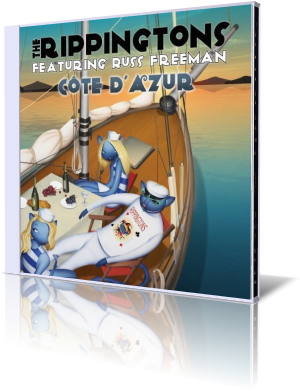|


 Listening
to Côte D’Azur, by the Rippingtons featuring Russ Freeman, is like
watching a half each of two different movies. Several songs sound like
they’re set in dance clubs where techno or electronica reigns. The rest
depend less on electronic effects. Listening
to Côte D’Azur, by the Rippingtons featuring Russ Freeman, is like
watching a half each of two different movies. Several songs sound like
they’re set in dance clubs where techno or electronica reigns. The rest
depend less on electronic effects.
Côte D’Azur, translated in English as Coast Azure, is more commonly
known in the Western world as the French Riviera. This region of southern
France inspired Freeman’s songwriting. His wife, singer/songwriter Yaredt
Leon, is part French.
In addition to Freeman, the Rippingtons are Rico Belled on bass, Dave
Karasony on drums, Bill Heller on keyboards and Jeff Kashiwa on
saxophones.
Sainte Maxime is an upbeat groove that features some of Freeman’s
elegant guitar play, partnered with saxophonist Jeff Kashiwa’s crystal
clear alto. The bass, drum and keyboard parts are subtle but effective.
Guitar and sax blend beautifully on the melody.
Postcard from Cannes is a picturesque soundscape. Led by Freeman’s
acoustic guitar, this track has a slight tropical air. The song also
features a bass solo by Belled, a rarity on a Rippingtons studio
recording. A charming companion piece is Passage to Marseilles.
With a Middle Eastern influence, this track is highlighted by Karasony’s
drum solo. It is not clear from the information provided whether this is
all Karasony or if Freeman performed the percussion.
Provence may be one of the most beautiful of Freeman’s ballads.
Belled, Karasony and Heller lay down the placid groove behind the electric
guitar. Though inspired by an afternoon ride through wine country, it
could easily be a midnight stroll on the beach at Cannes.
All 10 songs on Côte D’Azur clock in at 4 ½ minutes or less. The
time restraints are no guarantee of airplay. In a time when many radio
stations that played smooth jazz have either shut down or changed formats,
and those that remain active are more apt to play old music or R&B than
new releases that are safely within the format, it’s puzzling as to why
some in the industry believe keeping the music short will generate
popularity.
Still, Freeman demonstrates more freedom in his writing than he did with
2009’s Modern Art. The music is fresher and doesn’t seem forced.
Also, it helps plenty that Belled and Karasony are more involved this time
around. On Modern Art, it was as if they both were merely going
through the motions – striking the notes according to instruction, rather
than feeling the music.

|